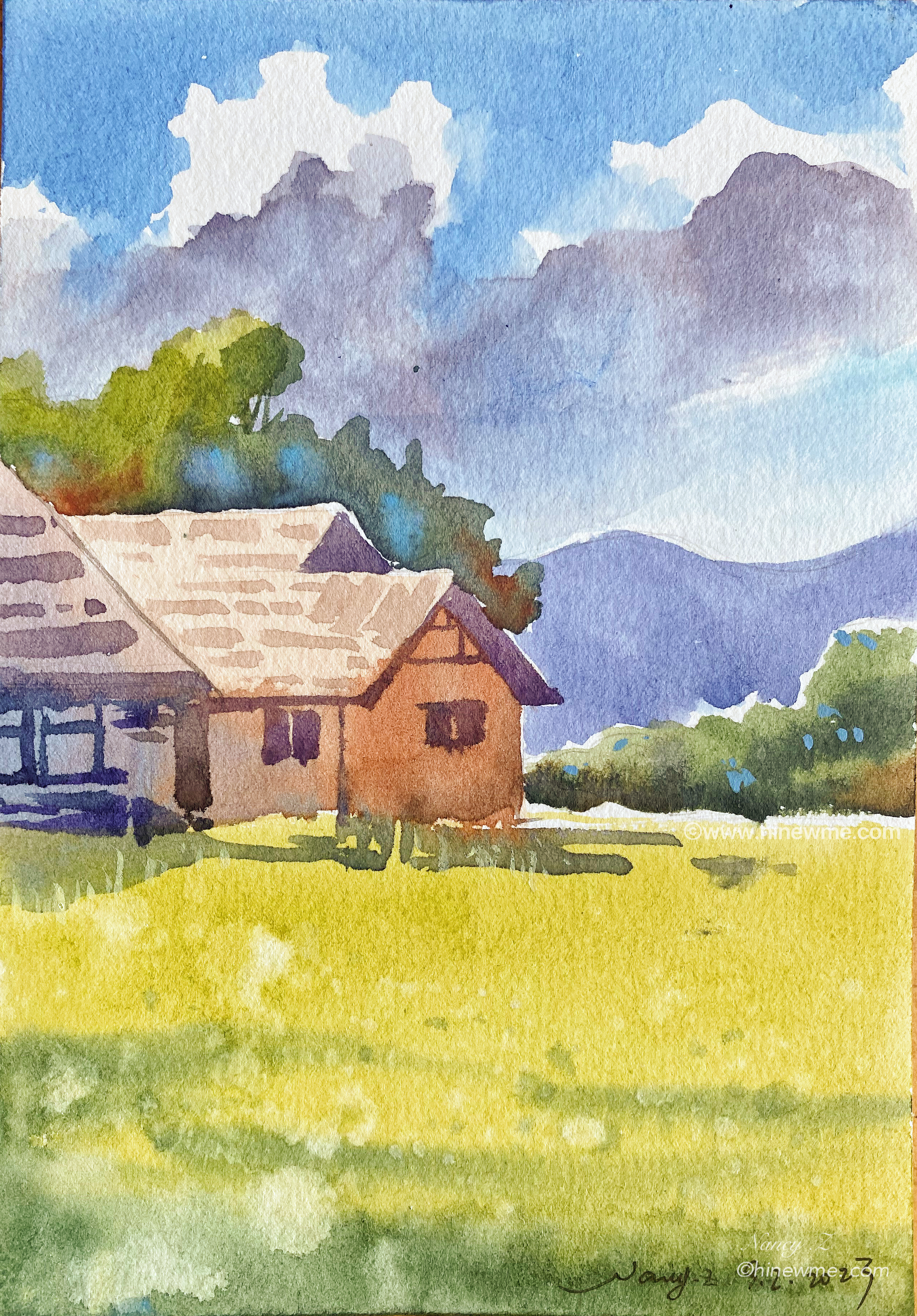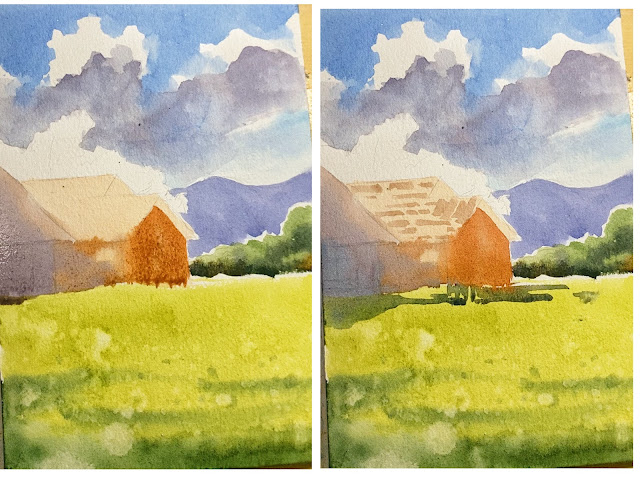4key points technique of watercolor.
The Cabin in the Mountains watercolor technique
Today's watercolor practice, painting a small cabin in the mountains. The four main techniques of watercolor:
1. The composition of the picture;
2. The primary and secondary relationship of the picture;
3. The relationship between black, white, and gray, that is, the relationship between light and shade;
4. Color warm and cold.
Before we draw this painting, we must design a draft in our mind and use the 4 methods.
Before drawing a draft, think about the composition of the picture. Generally, it is best to use the golden section method for composition. You can divide the picture into nine squares, just like the nine squares that appear when we usually take pictures with mobile phones.
The protagonist of the picture should be in the middle of the nine squares or on the border of the nine squares.
First, we determined that the main character is the cabin
and the lawn in the shadow of the cabin.
In the horizontal middle position of the nine squares, the width of the cabin accounts for 2/3 of the longitudinal direction of the nine squares.
This is the main part, and some details need to be portrayed, and the rest are secondary, which need to be blurred and highly outlined.
This is the main part, and some details need to be portrayed,
and the rest are secondary, which need to be blurred and
highly outlined.
The scientific nature of the composition will make the picture
look clear, and the visual focus will look more comfortable
Shading is divided into two parts:
1. The overall picture is divided into black, white, and gray in several large color blocks. For example: the sky is the white part, the grass is the gray part, and the cabin is the black part.
2. The black, white, and gray relationship of each large color block. For example: the small wooden house in the main body of the picture, its a black, white, and gray relationship: the black part is the leftmost part, revealing half of the tiny house; its white part, the brightest part, is the roof of the small wooden house; the gray part is the The walls of the log cabin.
A good grasp of black, white, and gray in the picture will make the overall feeling of the picture very comfortable. If the relationship between black, white, and gray is not well grasped, the image will appear very messy, trivial, and chaotic.
The third part is the warmth and coolness of the color.
Take this drawing as an example.
There are also some warm and cold changes in the shadowed part of the cloud. The distant mountain is the cool color part because it is far away.
The contrast between the vegetation in front of the distant mountain is: green which is warmer than the distant mountain, but this green is cooler than the grassy part at the front.
The distant mountains, vegetation, and grasslands have different temperatures and temperatures, and the farther forward the part is warmer, so the sense of space of the picture is widened, and the sense of space of the picture is widened with the warmth and coldness of colors.
Painting steps:
First, the draft. Use the above-mentioned method for line drawing—the golden section method and the nine-square grid composition method
Draw a general sense of space in your mind, and then use composition, light and dark relations, and warm and cold colors to express the sense of space and distance.
The third step is to draw the sky. Dip some waterless, add blue, and draw the junction of clouds and sky. Note: The combination of virtual and real, because some parts of the cloud outline are blurred, only the combination of virtual and real can draw a more natural cloud.
The third part is to draw distant mountains. Use a cool blue-purple to draw the silhouette of the distant mountain, because it is a distant mountain, so you don't need to draw it in detail, just draw a rough outline.
Draw the vegetation in front of the distant mountains. This vegetation is also relatively simple, but the simple light and shade relationship is used to show that the distance is closer.
Step 4 Draw the front lawn. Add some more water in warm green and paint the front lawn, since it's the closest part, it's a warmer color.
The green of the lawn is warmer than the vegetation in front of the distant mountains. The green of the whole picture uses the contrast of cold and warm to create a sense of distance.
Cool green is used at the front of the lawn to express the sense of volume of the lawn.
When the lawn is half-dry, flick some water on it with your fingers to make the lawn change.
The eighth step, complete the details. The grass in the shaded part of the cabin is drawn in white ink or gouache, and its grass shape is drawn.
Okay, now this beautiful and simple mountain cabin is finished.
Although simple, this painting requires a lot of practice. We are familiar with the techniques from these techniques, which will be of great help in future landscape paintings, and your pictures will become more and more beautiful and comfortable.
The part of the grass is also divided into warm and cold, and the front part is a cooler green so that the sense of volume of the grass is expressed.
The temperature of the log cabin, the house in the middle is a warm color, the farther to the left edge, the color becomes colder, and the shadow part of the log cabin is also a cool color. Use warm and cold colors to express the volume and three-dimensional sense of space of the cabin.
The trees behind the cabin use a cool green color. The green color here is cooler than the grass and warmer than the vegetation in front of the distant mountain. Because it is located between the grassland and the distant mountain vegetation, it uses warm and cool green. Open up the sense of space.
The shaded part of the tree behind the cabin will also be warm and cold, because of different light and different backgrounds, there will also be subtle changes in warm and cold in the dark part.
To sum up, attention should be paid to the picture: first, the composition; second, the relationship between primary and secondary; third, the relationship between light and shade of black, white, and gray; fourth, the warmth and coldness of colors.





































0 Comments